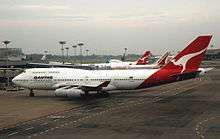Qantas Flight 1
 VH-OJH, the aircraft involved in the incident, photographed at Singapore Changi Airport. | |
| Incident summary | |
|---|---|
| Date | 23 September 1999 |
| Summary | Runway excursion caused by hydroplaning, pilot error aggravated by inclement weather |
| Site | Bangkok, Thailand |
| Passengers | 391[1]:1 |
| Crew | 19 |
| Fatalities | 0 |
| Injuries (non-fatal) | 38 (minor) |
| Survivors | 410 (all) |
| Aircraft type | Boeing 747–438 |
| Aircraft name | City of Darwin |
| Operator | Qantas |
| Registration | VH-OJH[2] |
| Flight origin | Sydney Airport |
| Stopover | Don Mueang Int'l Airport |
| Destination | London Heathrow Airport |
Qantas Flight 1 (QF1, QFA1) was a Qantas passenger flight which was involved in a runway overrun accident at Don Mueang International Airport as it was arriving for a stopover in Bangkok on 23 September 1999.
Flight
Qantas flights travel between London and Australia on a route known as the "Kangaroo Route". The Kangaroo Route traditionally refers to air routes flown between Australia and the United Kingdom, via the Eastern Hemisphere.
This flight was operated by a Boeing 747-438 c/n 24806-807, delivered to Qantas in August 1990 and registered VH-OJH. It began in Sydney earlier that day at 16:45 local time, and after more than eight hours' flying was approaching Don Mueang International Airport at 22:45 local time.
Incident
During the approach to Bangkok the weather conditions deteriorated significantly, from 8 km visibility half an hour before landing to 750 m at the time of landing.[1]:1 The flight crew observed a storm cloud over the airport and ground reports were that it was raining heavily. However, these conditions are common at Bangkok. Seven minutes prior to landing a Thai Airways Airbus A330 landed normally, but three minutes before landing another Qantas aircraft (QF15, a Sydney-Rome via Bangkok service), a Boeing 747, conducted a go-around due to poor visibility during final approach.[1]:3 The crew of Qantas Flight 1, however, were unaware of this.
The first officer was flying the plane during final approach. The aircraft's altitude and airspeed were high, but were within company limits. The rain was now heavy enough that the runway lights were visible only intermittently after each windscreen wiper stroke. Just before touchdown the captain, concerned about the long touchdown point (over a kilometre past the runway threshold) and unable to see the end of the runway, ordered the first officer to perform a "go-around" and the first officer advanced the throttles but did not engage the Takeoff/Go-around switch (TO/GA). At this point visibility improved markedly and the landing gear contacted the runway, although the aircraft continued to accelerate. The captain then decided to cancel the go-around by retarding the thrust levers, even though he was not flying the plane. This caused confusion as he did not announce his actions to the first officer who was still flying the plane. When over-riding the first officer's actions, the captain inadvertently left one engine at TO/GA power and as a result cancelled the preselected auto-brake settings.
The landing continued, but manual braking did not commence until the aircraft was over 1,600 metres down the runway. Then the plane proceeded to hydroplane and skid its way down the runway, departing substantially from runway centreline. Company standard operating procedure mandated that idle reverse thrust should be used for landings and that flaps should be set at 25 degrees,[1]:17 not the maximum of 30 degrees. The combination of flaps 25, no auto-braking, no reverse thrust, a high and fast approach, a late touch down, poor Cockpit Resource Management, and the standing water on the runway led to a runway overshoot.
The plane gradually decelerated, ran off the end of the runway, over a stretch of boggy grassland, colliding with a ground radio antenna as it did so, and came to rest with its nose resting on the perimeter road. The ground on the other side of the road forms part of a golf course.
Investigation
This incident was Qantas' most significant incident in fifty years of jet aircraft operation. The aircraft was returned to service and remained in the Qantas fleet until being withdrawn in October 2012 and subsequently scrapped.
Damage
The collision with the antenna caused the nose and right wing landing gear to collapse, the nose landing gear being forced back into the fuselage. The aircraft slid along in a nose-down, right wing low attitude, causing some further damage to the nose and damage to the two right engines and their mountings.
The intrusion of the nose landing gear also caused the failure of the cabin intercom and public address system.
There were no significant passenger injuries during an orderly evacuation of the aircraft ordered some 20 minutes after the rough landing. Thirty-eight passengers reported minor injuries. The aircraft was substantially damaged, but repaired at a cost of $100 million.[3] By returning the aircraft to service, Qantas was able to retain its record of having no hull-loss accidents since the advent of the Jet Age.
Qantas still operates flight number 1 between Sydney and London flying an Airbus A380-800, via Dubai.[4]
See also
- Runway safety area
- Engineered materials arrestor system
- China Eastern Airlines Flight 5398
- Air France Flight 358
Notes
- 1 2 3 4 Benns, Matthew (2009). The Men Who Killed Qantas. Sydney: William Heinemann:Australia. ISBN 978-1-74166-891-9.
- ↑ "CASA Aircraft Register". Civil Aviation Safety Authority.
- ↑ "How Qantas Became the Safest Airline". Quadrant Magaine. 1 January 2011.
- ↑ http://flightaware.com/live/flight/QFA1
Bibliography
External links
Accident description at the Aviation Safety Network